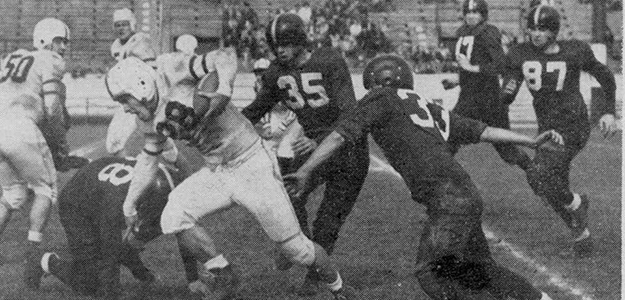What’s in a name? Tracing our ‘Marauder’ heritage

McMaster's teams haven't always had the same name. From the Rams to the Maroons, our teams tried a few nicknames before settling on Marauders - a name they share with a few other collegiate clubs.
Marauders we are, but Marauders we haven’t always been.
When McMaster storms the field against Laval at Friday’s Vanier Cup, they’ll be joined by a sea of students, staff and alumni dressed in maroon and grey “Marauders” apparel. But we haven’t always used that name, or those colours, to cheer on our teams.
Back in 1912, when the University was still located on Bloor Street in downtown Toronto, football and rugby players regularly took to the field in green and black sweaters – not maroon and grey. According to historian and alumnus Charles Johnston (author of History of McMaster University Vols I and II), our current school colours were recommended that year by a local artist due to their “washability and complementary characteristics.” In other words, they looked nice and were easy to clean after a day in the mud.
Writes Johnston: “With this momentous decision out of the way, the University turned to the matter of obtaining a new campus where McMaster’s resplendently attired teams could display their prowess.” Relocating to Hamilton was on the horizon (spurred in large part by the Athletic Association’s desire for more land and a new playing field), but University teams still lacked a unified name.
In the McMaster Football Media Guide, author Ian Speers touches on the great nickname conundrum during the mid-20th century. For much of the 1930s and ’40s, the football team was simply referred to as the “Maroons,” in reference to one of the school’s primary colours. For a brief period between 1945 and 1948, McMaster footballers competed as the “Rams,” before finally settling on the name “Marauders” near the end of the decade.
In his colourful and celebrated 1975 book Over the Ivy Wall, Les Prince describes the earliest days of Marauder football as “building years,” but the tide was quickly turning. Notable players during the 1940s and ’50s included the likes of Lincoln Alexander, Mel Hawkrigg, Lorne Wrigglesworth and future CFL legend and Canadian Football Hall of Famer Russ Jackson.
Not all teams came on board with the new monicker, however. As late as the 1960s, the men’s hockey program was competing as the “Marlins,” and captured their first and only University Cup in 1963 under head coach Les Prince. The women’s hockey team also had a distinct and quirky nickname. In 100 Years of McMaster Trivia (compiled by Prince and co-author Doug Allaby and published in 1987), the women’s intercollegiate squad is not referenced as the Marauders, but simply as “Lady Mac.”
It took decades to become entrenched, but where did the name “Marauders” actually come from?
That honour is officially credited to Bill Cline, who wrote a letter to The Silhouette in 1948 and innocently suggested the name “Maroon Marauders” for the men’s basketball team. The “Maroon” was eventually dropped but “Marauders” stuck, and quickly became synonymous with most University teams and athletes. A photo in the 1949 Marmor yearbook highlights the original “Maroon Marauders,” coached by Athletic Director Ivor Wynne and Les Prince.
Room for more? McMaster University is not the lone Marauder in North America. Millersville University in Millersville, Pennsylvania also refers to its sports teams as the Marauders, although their “M” logo includes a pirate and sword, rather than a bird. Antelope Valley College in Lancaster, California also competes under the Marauder name.
Do you know of another McMaster team nickname? Email daily@mcmaster.ca and share your story.


